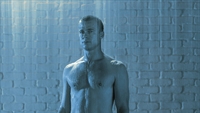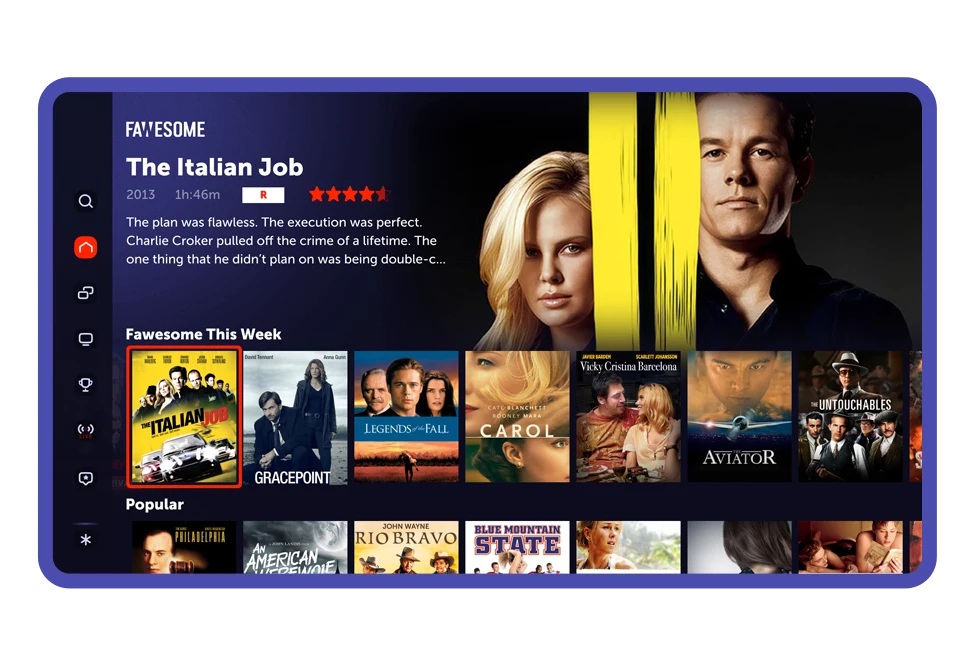HD takes still life to next level for artist Robert Wilson

Photo courtesy: VOOM HD Networks, RW Works and Pavel Antonov">
Readers of Vanity Fair may recall the cover story in theNovember issue about “king of the avant-garde” Robert Wilson’s high definition video portraits.
Working since 2004 on the project with VOOM HD Networks as its artist-in-residence, Wilson has produced 50 sytlized HD video portraits of celebrities produced to be viewed on flat panel HDTVs hung on the wall like pictures. The HD video portraits cast celebrities like Brad Pitt, Steve Buscemi and Winona Ryder in unique settings where exceedingly slow movement is presented in roughly five-minute loops to bring a new dimension to term “still life.” Next month the video portraits will go on display at the Paula Cooper Gallery, Phillips de Pury & Company, and Nathan A Bernstein Gallery in New York.
HD Technology Update spoke with VOOM HD Networks general manager Greg Moyer and Ali Hossaini, executive producer of the VOOM portraits project, about working with Wilson and how HD help him achieve his artistic vision.
HD Technology Update: I’ve read Robert Wilson has a long history of using video as a medium for portraiture going back to Video 50 — 30-second long video portraits — in the 1970s. Fast forward to 2006 and HD with its greater resolution, but still video. What is the attraction to video for this art form as opposed to other alternatives, most notably film?
Ali Hossaini: Bob Wilson prefers to work in video because his background is in the theater, so he really has a notion of the stage and a frame. He is a theater director and a visual artist. So, video, unlike film, is displayed in a frame, the physical border of the TV set. The other part of it is that he wants to create these artifacts that sit on the wall in the tradition of paintings, and film is really a projected art form and doesn't deal with a frame, and it doesn’t persist on the wall.
The other idea of the video portrait is to do a very playful extension of the painting. Wilson is noted for very, very slow movement in all of his theater and film work that he has done before. In this case, he wanted to create these things that almost look like still life on the wall, but then they started gradually to move. The more you watch them, the more you see in terms of that movement. They sit up on your wall as permanent installations, so video is the perfect medium for this kind of exercise.
Get the TV Tech Newsletter
The professional video industry's #1 source for news, trends and product and tech information. Sign up below.
HDTU: You’ve addressed video as being well suited for display. I was thinking more in terms of acquisition. Why is HD the right medium for acquisition for this project?
AH: Wilson has a very, what you might call, empirical technique. In other words, he has a vision of what he wants, but there's not a distinct plan for getting there. So you need to be able to experiment, and video allows for endless real-time experimentation with instant feedback on a monitor.
You know, we use a [Sony RMB 750] Paintbox with a very high-end video engineer live on these shoots, and it has to be video acquisition because we’re going to change the color, the tone and the lighting probably a thousand times before we get what we want.
Wilson is known for his lighting, so that part is very important. At least 50 percent of it happens in the Paintbox and physical adjustments with the camera, so it's critical.
HDTU: What camera and lens or lenses were used for this video portrait project? What was the recording medium? What resolution and frame rate?
AH: We used a Sony HDW F900 CineAlta camera. We also used a Canon 11X 4.7mm Cine Zoom lens. We recorded to HDCAM tape in 1080i 59.97 interlaced. So, we went for a full 1920 x 1080 acquisition — took full advantage of the medium.
Canon was very generous letting us use that lens for free on the last two shoots. We needed the cine-style lens. We were using the full video frame on these. We were getting vignetting and distortion with ENG lenses. So in this case, the cine-style lens was a critical factor in the success of the project.
HDTU: Could you describe VOOM HD Networks’ involvement in this project? The Vanity Fair article said Wilson was seeking clients for video portraits. Is VOOM HD Networks involved in that too?
Greg Moyer: Really, this whole project is made possible because of VOOM. We brought Robert Wilson to high definition in some regards. He'd been using the medium prior, but we facilitated every aspect of the portraits. I learned that he would take a commission to do a video portrait in that article. The bulk of these portraits that we've been behind, there’s no money that’s changed hands and it’s not been because there's been a paying patron who wanted their portrait made. I think there were a handful of exceptions to that, but for the most part, we used recognizable stage or movie stars, and they have not paid us anything, and we've not paid them anything.
AH: Wilson hopes to take this in a direction where he's taking commissions. That was the focus of that article. That was always a goal of Wilson as an artist, but this whole project that we've done with him is actually something that we approached him on. He's made one video portrait in standard def about 15 or 20 years before. It was not something that anyone was happy with. We wanted to produce a project with Robert Wilson and approached him and discussed several ideas and came up with the video portraits. Like any artist’s studio, they have this dream of cranking out commissions, but so far, it's been a relationship where we've done something that's more recognizable as programming rather than as a commissioned art.
HDTU: Are these video portraits done in one take, or are they edited segments? I understand that the beginning and end are edited together to create loops for exhibition. I’m referring to what goes on from the beginning to end of the loop.
AH: Just for context, we do multiple takes. One take is selected to be the basis of the loop, so that one take becomes a cycle in the loop. Actually, this gets back to the whole HD acquisition question. That cycle is very heavily manipulated within the acquisition process, and from there on out, we really have to use high-end people to even work the gear because the Avid DS [Nitris] system that we use is also getting pushed to its limit as a Paintbox for changing the tempo of it — slowing it down, speeding it up in places or painting over things to lose some distracting details, and in some cases, adding something that will smooth out a line to create this very high-end creamy sort of image. It takes that amount of the manipulation to create an indistinguishable loop.
GM: I guess the goal is to make it look as if it were a simple one-take solution, but actually there’s a lot of manipulation. I remember Ali saying that any one of these sittings can take hours even though the final product may only be a 12-minute piece of video.
AH: It's true. We actually use a grease pencil to draw on the monitor to help guide the subject back to their initial starting point. But even with that, it's difficult to get their fingers to be right in the same place. So, the idea is to make them move indistinguishably so you never see the beginning or the end. You’re watching it, and you don't even know they've come to an end. It looks like it's going on and on, and we've been very successful in that regard. The illusion is complete.
HDTU: The Vanity Fair article says Wilson estimates the cost to produce each at $40,000. Do you agree? Does that sound right from your perspective, and if so, how much of that is the expense of the technology and how much is design, sets, costumes, etc.?
AH: Actually, Wilson was grossly underestimating the cost of this. That is basically how much cash goes out the door during the window of the production cycle. That $40,000 covers basically design, sets, costumes and the immediate crew expenses, not things we’ve paid in advance — everything from hotel and travel to the enormous cost of production overhead. It doesn't include the editing. Each of these things, even though the cycle is only five minutes, although you get an infinite loop, takes about 30 hours to edit. So, that doesn't include either the editor’s time or the overhead of the edit suites that we own. They’re covered in the general cost. I would say it probably costs $100,000 all said and done when you count in the overhead contributed by the company. We don’t rent cameras and edit suites because we already own them. There's a lot of staff that can be put onto these that are coming out of the general expense line.
GM: So VOOM’s contribution is greater than the direct cost that we would pay to third parties to make these things happen.
HDTU: Commercial broadcast television hasn’t in the past been able to sustain this type of programming, leaving the arts and culture largely to public television and then select cable networks. Can high definition help attract a larger audience to arts programming, or are you looking to America’s infatuation with celebrities to attract viewers to these video portraits from Robert Wilson?
AH: They’ll come for the celebrities, and they’ll stay for the art.
GM: I think Ali has the right answer. We sort of need both. I think one of the real surprises and one of the real joys of doing high definition has been sort of the resurrection of programming formats that really didn't make a huge impact on people when they were available only in standard def. The arts and visual arts programming is a terrific example of that.
It's just so much more intimate, and alive and immediate for you to see art that's been captured on high def on your monitor than to watch it after it's been sort of photographed using standard-def technology.
You can really almost tele-presence yourself to the museum or into the experience that's being recorded, and I think that really intensifies the emotional connection to the material. That truly benefits the visual arts on television — to have high def.
I think that just as the proverbial hockey puck, which is now visible in high def and tough to see in standard def, benefits enormously from a this technology, so will the visual arts.
But Ali's point as well is that what we’re excited by is that this is a very happening kind of contemporary art form that is attracting the likes of movie celebrities and people who have names and reputations. They want to be part of something that's perceived as cutting edge and innovative. We welcome that because obviously people love the idea that we have Brad Pitt in his underwear for 10 minutes. That's not a view the most people get very often. I'm glad we have the celebrity involvement. I don't deny that it adds to the curiosity factor and may make this whole project a lot more accessible for people.
Tell us what you think!
HDTU invites response from our readers. Please submit your comments to editor@broadcastengineering.com. We'll follow up with your comments in an upcoming issue.
